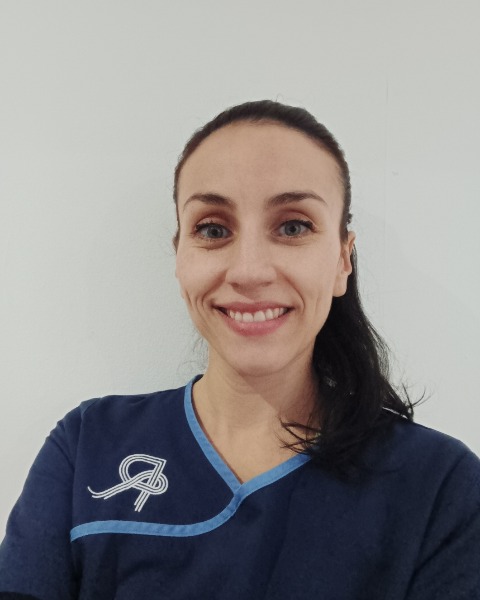Embryo/Fetus
Poster Session A
(P-072) How Important is Fast Re-expansion of FETs After Thawing on Implantation Rate?
Wednesday, July 17, 2024
8:00 AM - 9:45 AM IST
Room: The Forum

Jorgelina C. Razeto (she/her/hers)
Trainee Embryologist
Repromed Dublin
Dublin, Dublin, Ireland
Poster Presenter(s)
Abstract Authors: Jorgelina Razeto (Repromed Dublin, Ireland), Florencia Steinvarcel (Repromed Dublin, Ireland)
Abstract Text:
Objective: to evaluate the importance of fast blastocyst re-expansion on frozen-thawed embryos at the time of transfer on implantation rates.
Design: Retrospective single-centre observational cohort study.
Materials and method: 303 FETs were reviewed from July to December 2023. All FETs with full detailed information about the embryo re-expansion after thaw were included. These cycles included patients using autologous, donor oocytes, and donor embryos with patients ranging from ages 23 to 49 years with infertility diagnoses. Embryos were evaluated by at least one senior embryologist or a senior and a junior embryologist to register embryo re-expansion and categorized them into 3 features (fully re-expanded, re-expanding, or collapsed) 2 hours after thawing or one hour before the transfer. When DET took place, if any embryo was re-expanded or expanding then that category was considered. After a general analysis, we decided to also divide patients by group age (< 35 years old, 35-38 years old, 38-40 years old, >40 years old), PGT or not, and egg donor program (including all programs offered at the clinic).
Results: From all FETs analyzed, 87% of them (264) were considered fully re-expanded or re-expanding before transfer. 40% resulted in positive beta results and 60 % resulted in negative beta. From the positive beta group, only 3 (2.5%) were collapsed at transfer time, the rest of them were either fully-expanded or re-expanding. The negative beta group included 80% fully re-expanded or re-expanding embryos and 20% collapsed.
We applied the Chi-square test to evaluate the correlation between the variables and found the features collapsed or re-expanded/ing as an important aspect for the embryo to implant (p-value< 0.05). When analyzing PGT or not, this feature did not show a correlation with implantation results (p-value >0.05). The feature donor or own egg also did not show a correlation (p-value > 0.05) Finally the group age showed a correlation for the implantation process positioning the younger group as the most advantageous (p-value< 0.05).
Lastly, we calculated the difference between the observed cases and discovered that an embryo re-expanded/ing has 37% more chances of implantation when compared to a collapsed one.
There seems to be a correlation between fast expansion after thaw and positive beta. This may mean that collapsed embryos have more challenges to implant.
Limits and improvements: We had a limited number of cycles with full information to evaluate. We only evaluated implantation rate, as a way of predicting the embryo’s potential to lead to a possible pregnancy. Implantation does not only depend on the embryo's fast expansion ability. We did not include % of survival rate after thawing as a feature.
Abstract Text:
Objective: to evaluate the importance of fast blastocyst re-expansion on frozen-thawed embryos at the time of transfer on implantation rates.
Design: Retrospective single-centre observational cohort study.
Materials and method: 303 FETs were reviewed from July to December 2023. All FETs with full detailed information about the embryo re-expansion after thaw were included. These cycles included patients using autologous, donor oocytes, and donor embryos with patients ranging from ages 23 to 49 years with infertility diagnoses. Embryos were evaluated by at least one senior embryologist or a senior and a junior embryologist to register embryo re-expansion and categorized them into 3 features (fully re-expanded, re-expanding, or collapsed) 2 hours after thawing or one hour before the transfer. When DET took place, if any embryo was re-expanded or expanding then that category was considered. After a general analysis, we decided to also divide patients by group age (< 35 years old, 35-38 years old, 38-40 years old, >40 years old), PGT or not, and egg donor program (including all programs offered at the clinic).
Results: From all FETs analyzed, 87% of them (264) were considered fully re-expanded or re-expanding before transfer. 40% resulted in positive beta results and 60 % resulted in negative beta. From the positive beta group, only 3 (2.5%) were collapsed at transfer time, the rest of them were either fully-expanded or re-expanding. The negative beta group included 80% fully re-expanded or re-expanding embryos and 20% collapsed.
We applied the Chi-square test to evaluate the correlation between the variables and found the features collapsed or re-expanded/ing as an important aspect for the embryo to implant (p-value< 0.05). When analyzing PGT or not, this feature did not show a correlation with implantation results (p-value >0.05). The feature donor or own egg also did not show a correlation (p-value > 0.05) Finally the group age showed a correlation for the implantation process positioning the younger group as the most advantageous (p-value< 0.05).
Lastly, we calculated the difference between the observed cases and discovered that an embryo re-expanded/ing has 37% more chances of implantation when compared to a collapsed one.
There seems to be a correlation between fast expansion after thaw and positive beta. This may mean that collapsed embryos have more challenges to implant.
Limits and improvements: We had a limited number of cycles with full information to evaluate. We only evaluated implantation rate, as a way of predicting the embryo’s potential to lead to a possible pregnancy. Implantation does not only depend on the embryo's fast expansion ability. We did not include % of survival rate after thawing as a feature.
